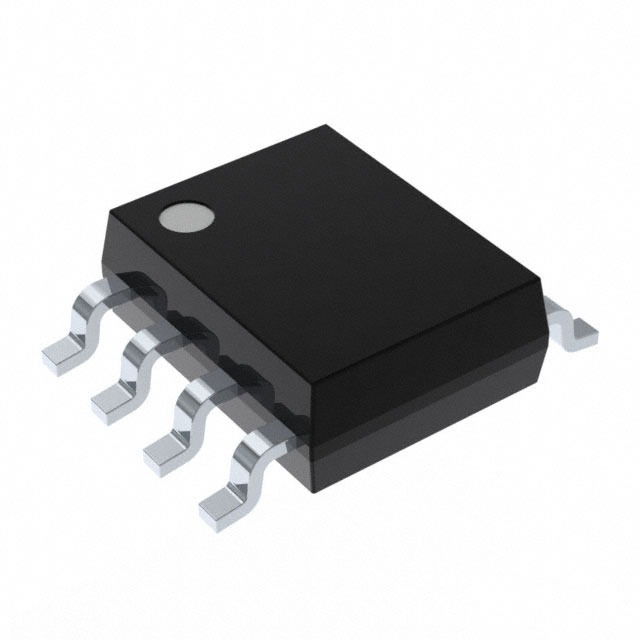Szczegóły produktu można znaleźć w specyfikacjach.

MAX5940AESA+T
Product Overview
- Category: Integrated Circuit (IC)
- Use: Power Management
- Characteristics: High-efficiency, low-power, step-down DC-DC converter
- Package: 8-pin SOIC (Small Outline Integrated Circuit)
- Essence: Voltage Regulator
- Packaging/Quantity: Tape and Reel, 2500 units per reel
Specifications
- Input Voltage Range: 4.5V to 60V
- Output Voltage Range: 0.8V to 55V
- Output Current: Up to 1.5A
- Switching Frequency: 100kHz to 2MHz
- Efficiency: Up to 95%
- Operating Temperature Range: -40°C to +125°C
Pin Configuration
The MAX5940AESA+T has the following pin configuration:
- VIN: Input voltage pin
- GND: Ground pin
- FB: Feedback pin for output voltage regulation
- EN: Enable pin to control the device operation
- SS/TR: Soft-start/Tracking pin for controlling the startup behavior
- PG: Power Good pin indicating the output voltage is within regulation limits
- LX: Switching node pin for connecting the inductor
- VOUT: Output voltage pin
Functional Features
- High efficiency conversion of input voltage to regulated output voltage.
- Wide input voltage range allows for versatile applications.
- Adjustable output voltage through external resistors.
- Soft-start feature for controlled startup behavior.
- Power Good indicator for monitoring output voltage stability.
- Overcurrent protection and thermal shutdown for enhanced safety.
Advantages and Disadvantages
Advantages: - High efficiency results in reduced power consumption. - Wide input voltage range enables compatibility with various power sources. - Adjustable output voltage provides flexibility for different applications. - Power Good indicator ensures reliable operation. - Overcurrent protection and thermal shutdown enhance safety.
Disadvantages: - Limited output current may not be suitable for high-power applications. - Requires external components for proper operation. - Higher cost compared to non-integrated solutions.
Working Principles
The MAX5940AESA+T is a step-down DC-DC converter that converts a higher input voltage to a lower regulated output voltage. It utilizes a switching regulator topology to achieve high efficiency. The input voltage is first rectified and filtered, then fed into the integrated circuit. The IC controls the switching of an internal power transistor to regulate the output voltage according to the feedback received from the FB pin. The soft-start feature ensures a controlled startup, while the power good pin indicates when the output voltage is within regulation limits. Overcurrent protection and thermal shutdown mechanisms provide additional safety.
Detailed Application Field Plans
The MAX5940AESA+T can be used in various applications, including but not limited to:
- Industrial Automation: Powering control systems, motor drives, and sensors.
- Automotive Electronics: Providing power to infotainment systems, lighting modules, and advanced driver-assistance systems (ADAS).
- Telecommunications: Powering base stations, routers, and network switches.
- Consumer Electronics: Powering portable devices, home appliances, and audio/video equipment.
- Renewable Energy: Powering solar inverters, wind turbines, and energy storage systems.
Detailed and Complete Alternative Models
- LM2596S-ADJ: Step-down DC-DC converter with adjustable output voltage.
- LT1763-3.3: Low dropout linear regulator with fixed 3.3V output voltage.
- TPS54331-Q1: Automotive-grade synchronous buck converter with wide input voltage range.
- MP2307DN: High-efficiency step-down converter with integrated power MOSFET.
- ADP2302ARDZ-3.3: Dual-channel, 3.3V output voltage regulator with low dropout voltage.
These alternative models offer similar functionality and can be considered as alternatives to the MAX5940AESA+T based on specific requirements and design constraints.
Word count: 526 words
Wymień 10 typowych pytań i odpowiedzi związanych z zastosowaniem MAX5940AESA+T w rozwiązaniach technicznych
Sure! Here are 10 common questions and answers related to the application of MAX5940AESA+T in technical solutions:
Q: What is the MAX5940AESA+T? A: The MAX5940AESA+T is a power-over-Ethernet (PoE) controller IC designed for use in network devices that require power delivery over Ethernet cables.
Q: What is the maximum power output of the MAX5940AESA+T? A: The MAX5940AESA+T can deliver up to 13W of power to the connected device.
Q: Can the MAX5940AESA+T be used with both 10/100Mbps and Gigabit Ethernet networks? A: Yes, the MAX5940AESA+T is compatible with both 10/100Mbps and Gigabit Ethernet networks.
Q: Does the MAX5940AESA+T support Power Sourcing Equipment (PSE) detection? A: Yes, the MAX5940AESA+T supports PSE detection, allowing it to identify whether a connected device is PoE-compatible.
Q: Can the MAX5940AESA+T provide power to multiple devices simultaneously? A: No, the MAX5940AESA+T is a single-port PoE controller and can only provide power to one device at a time.
Q: What is the input voltage range supported by the MAX5940AESA+T? A: The MAX5940AESA+T supports an input voltage range of 36V to 57V.
Q: Is the MAX5940AESA+T compatible with IEEE 802.3af/at standards? A: Yes, the MAX5940AESA+T is fully compliant with the IEEE 802.3af/at standards for PoE.
Q: Does the MAX5940AESA+T have built-in thermal protection? A: Yes, the MAX5940AESA+T features built-in thermal protection to prevent overheating and ensure safe operation.
Q: Can the MAX5940AESA+T be used in industrial applications? A: Yes, the MAX5940AESA+T is suitable for use in industrial applications due to its wide operating temperature range and robust design.
Q: What package does the MAX5940AESA+T come in? A: The MAX5940AESA+T is available in an 8-pin SOIC (Small Outline Integrated Circuit) package.
Please note that these answers are general and may vary depending on the specific application and requirements. It's always recommended to refer to the datasheet and consult with the manufacturer for detailed information.

